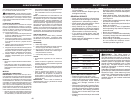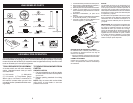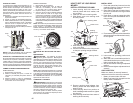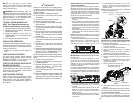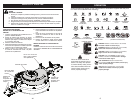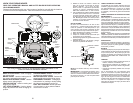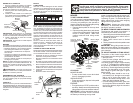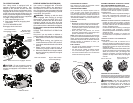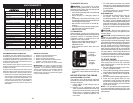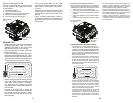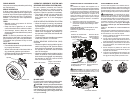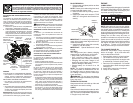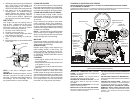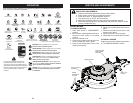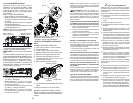
40
MANTENIMIENTO
IMPORTANTE: No aceite ni engrase los puntos
de los pivotes que tienen cojinetes de nailon
especiales. Los lu bri cantes viscosos atraerán
el polvo y la suciedad, lo que redu cirá la vida de
los cojinetes autolu bri cant es. Si siente que se
deben lu bri ca r, use sólo un lubri cante tipo grafito
en po lv o modera da mente.
RECOMENDACIONES GENERALES
La garantía para esta cortadora de césped no
ampara los artículos que se han sometido al abuso
o la negligencia del operador. Para recibir el valor
completo de la garantía, el operador debe darle
man tenimiento a la cortadora de césped conforme
se indica en este manual.
Será necesario hacer algunos ajustes en forma
periódica para mantener de manera correcta la
cortadora de césped.
Al menos una vez cada temporada, revise si usted
debe hacer algún ajuste conforme se describe en
la sección de Servicio y Ajustes de este manual.
• Al menos una vez al año usted deberá cambiar la
bujía, limpiar o cambiar el filtro de aire y revisar
si la cuchilla y la cinta están desgastadas. Una
nueva bujía y un nuevo filtro de aire aseguran
la mezcla adecuada de aire y combustible, lo
que ayuda a que el motor funcione mejor y dure
más tiempo.
ANTES DE CADA USO
1. Revise el nivel del aceite del motor.
2. Revise la operación del freno.
3. Revise la presión de las llantas.
4. Revise que los sistemas de presencia del
operador y de ROS funcionen bien.
5. Revise que los broches no estén sueltos.
#
/
2
4
!
$
/
2
!
ª
$
%
ª
#
²
3
0
%
$
#!$!ª
ª
(/2!3
#!$!ª
ª
(/2!3
#!$!ª
ª
(/2!3
#!$!ª
ª
(/2!3
#!$!ª
4%-0/2!$!
!,-!#%.!-)%.4/
!.4%3ª$%ª
#!$!ª53/
ª#AMBIARªMÈSªAªMENUDOªCUANDOªSEªOPEREªBAJOªCARGAªPESADAªOªENªAMBIENTESªCONªALTASªTEMPERATURAS
ª$ARªSERVICIOªMÈSªAªMENUDOªCUANDOªSEªOPEREªENªCONDICIONESªSUCIASªOªPOLVOROSAS
ª#AMBIARªLASªCUCHILLASªMÈSªAªMENUDOªCUANDOªSEªSIEGUEªENªSUELOªARENOSOª
Revisar la operación del freno
Revisar la presión de las llantas
Revisar la presencia del operador y el
sistema ROS
Revisar que los broches no estén sueltos
Revisar/cambiar la cuchilla de la cortadora
de césped
Limpiar la batería y las terminales
Lubricar los ejes y husos
Revisar el enfriamiento del transeje
Revisar la nivelación de la cortadora
de césped
Revisar la cinta en V
Aceitar las cadenas del impulsor
Revisar el nivel del aceite del motor
Revisar el aceite del motor
Limpiar la filtro de aire
Limpiar la pantalla de aire
Inspeccionar el silenciador/parachispas
Limpiar las aletas de enfriamiento del motor
Cambiar la bujía
Cambiar el cartucho de papel del filtro
de aire
13
ADD GASOLINE
• Fill fuel tank to bottom of filler neck. Do
not overfill. Use fresh, clean, regular
un lead ed gasoline with a minimum of
87 octane. (Use of leaded gasoline will
increase carbon and lead oxide deposits
and reduce valve life). Do not mix oil with
gasoline. Purchase fuel in quan ti ties that
can be used within 30 days to assure fuel
freshness.
CAUTION: Wipe off any spilled oil or
fuel. Do not store, spill or use gasoline near
an open flame.
CAUTION: Alcohol blended fuels (called
gasohol or using ethanol or methanol) can
attract moisture which leads to separation
and for ma tion of acids during storage. Acidic
gas can damage the fuel system of an engine
while in storage. To avoid engine problems,
the fuel system should be emptied before
stor age of 30 days or longer. Drain the gas
tank, start the engine and let it run until the
fuel lines and carburetor are empty. Use fresh
fuel next season. See Storage In struc tions
for additional information. Never use engine
or carburetor cleaner products in the fuel tank
or permanent damage may occur.
TO START ENGINE
When starting the engine for the first time or
if the engine has run out of fuel, it will take
extra cranking time to move fuel from the
tank to the engine.
1. Be sure freewheel control is in the trans-
mis sion en gaged position.
2. Sit on seat in operating position, depress
clutch/brake pedal and set parking brake.
3. Place motion control lever in neutral (N)
position.
4. Move deck clutch to dis en gaged position.
5. Insert key into ignition and turn key
clock wise to start position and release
key as soon as engine starts. Do not run
starter continuously for more than fifteen
sec onds per minute.
NOTE: If at high altitude (above 3000 feet)
or in cold temperature (below 32°F/0°C) the
fuel mixture may need to be adjusted for best
performance.
TO TRANSPORT
When pushing or towing your riding mower,
be sure to disengage transmission by placing
freewheel control in freewheel position.
Freewheel control is located at the rear
drawbar of the riding mower.
• Raise mower height adjustment to its
highest position with mower height
adjustment lever.
• Push freewheel control down and over
with foot.
TO OPERATE ON HILLS
WARNING: Do not drive up or down
hills with slopes great er than 15° and do not
drive across any slope. Use the slope guide
at the back of this manual.
• Choose the slowest speed before starting
up or down hills.
• Avoid stopping or changing speed on
hills.
• If stopping is absolutely necessary, push
clutch/brake pedal quickly to brake position
and engage parking brake.
• Move motion control lever to neutral (N)
position.
• To restart movement, slowly re lease park-
ing brake and clutch/brake pedal.
• Make all turns slowly.
• To reengage transmission, reverse above
procedure, or press brake lever all the way
down.
BEFORE STARTING THE ENGINE
CHECK ENGINE OIL LEVEL
The engine in your riding mower has been
shipped from the factory already filled with
sum mer weight oil.
1. Check engine oil with riding mower on
level ground.
2. Remove oil fill cap/dipstick and wipe
clean, reinsert the dipstick and screw cap
tight, wait for a few seconds, remove and
read oil level. If nec es sary, add oil until
“FULL” mark on dipstick is reached. Do
not overfill.
Freewheel
Control
Disengaged
Freewheel
Control
Engaged
• For cold weather operation you should
change oil for easier starting (See the oil
viscosity chart in the Main te nance sec tion
of this man u al).
• To change engine oil, see the Main te-
nance section in this manual.



